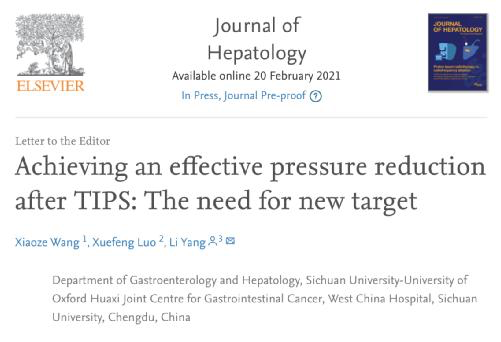In January and February , 2021, the research team of Prof. Li Yang and Associate Prof. Xuefeng Luo from the Department of Gastroenterology and Hepatology, Sichuan University-University of Oxford Huaxi Joint Centre for Gastrointestinal Cancer, West China Hospital, published in Hepatology and Journal of Hepatology two research papers on the treatment of liver cirrhosis. The two papers are“Endoscopic Cyanoacrylate Injection vs BRTO for Prevention of Gastric Variceal Bleeding: A Randomized Controlled Trial” and “Achieving an Effective Pressure Reduction After TIPS: The Need for New Target” in the form of a letter.
The first authors are Xuefeng Luo and Xiaoze Wang respectively, and Prof, Li Yang is the corresponding author of both papers. The research work is funded by the National Natural Science Foundation of China and the1.3.5 Project for Disciplines of Excellenceof West China Hospital, Sichuan University.

“The optimal treatment for gastric varices (GVs) has not yet been fully determined. This study compared the efficacy and safety of endoscopic cyanoacrylate injection and balloon-occluded retrograde transvenous obliteration (BRTO) to prevent rebleeding in patients with cirrhosis and GVs after primary hemostasis. Patients with cirrhosis and history of bleeding from gastroesophageal varices type 2 or isolated gastric varices type 1 were randomized to cyanoacrylate injection (n = 32) or BRTO treatment (n = 32). ---The survival rates, frequency of complications, and worsening of EVs were similar in both groups. BRTO resulted in fewer hospitalizations, inpatient stays, and lower medical costs. CONCLUSIONS: BRTO is more effective than cyanoacrylate injection in preventing rebleeding from GVs, with similar frequencies of complications and mortalities.” (Abstract)

Transjugular intrahepatic portosystemic shunt (TIPS) is widely used in the treatment of portal hypertension and its complications. [1]. “Jaume Boschalso suggested small diameter TIPS, combined with other procedures or pharmacological therapy when necessary, might favour avoiding hepatic encephalopathy. We would like to compare the outcomes of patients with portal pressure gradient (PPG) > 12 mmHg and those with PPG ≤ 12 mmHg after TIPS creation.”The current hot issue is how to balance the blood pressure of portal vein and avoid excessive shunt by selecting the stent with the diameter of tips and the goal of reducing blood pressure .
In view of this, the digestive intervention team of West China Hospital retrospectively analyzed the clinical prognosis of patients with PSG greater than 12mmHg and less than 12mmHg after TIPS from June 2015 to April 2019, and found that there was no difference in rebleeding rate and mortality. This study, published in letter form in Journal of Pathology, confirmed Professor Jaume Bosch's hypothesis of small diameter TIPS with reliable clinical data.
Under the leadership of Prof. Li Yang and Associate Professor Xuefeng Luo, the digestive intervention team focuses their research on the multidisciplinary diagnosis and treatment of chronic liver disease, cirrhosis, liver tumor and liver vascular disease. They have made great achievements and won the first prize of Sichuan Provincial Science and Technology Progress Award. Moreover, the team has been invited to revise the Baveno VII consensus, which is the most influential guideline for diagnosis and treatment of portal hypertension in the world. As a main member, the team has written 5 guidelines of the Chinese Medical Association and the Chinese Medical Doctor Association.
